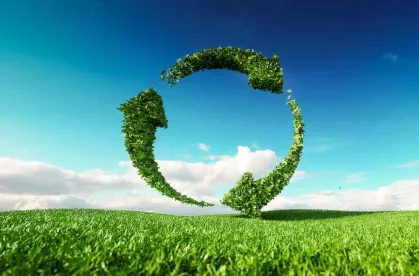On November 2, 2021, the EPA announced a proposed rule aimed at reducing methane emissions from oil and gas sources.1 The proposed rule is part of the Biden Administration’s U.S. Methane Emissions Reduction Action Plan, which was simultaneously unveiled by the EPA as President Biden and world leaders met at the 2021 United Nations Climate Change Conference, or COP26. Although the proposed rule is preliminary in nature and does not yet include the proposed regulatory text, it signals a first step in the EPA’s forthcoming efforts to amend current regulations and adopt new regulations combatting methane emissions.
Background
The proposed rule follows many years of fluctuating methane emission regulations on the part of the EPA. Acting under the Obama Administration in 2016, the EPA promulgated a final rule that updated the 2012 New Source Performance Standards (“NSPS”), located at 40 CFR Part 60, to target volatile organic compound ("VOC") and methane emissions from oil and gas sources, including wells, storage vessels, certain controllers and compressors, and other industrial equipment.2 Subpart OOOO of the NSPS applies to sources constructed, modified, or reconstructed after August 23, 2011, but on or before September 18, 2015, while Subpart OOOOa of the NSPS applies to all sources constructed, modified, or reconstructed after September 18, 2015.3
On September 14, 2020, the EPA rolled back the 2016 rule significantly by adopting the 2020 Policy Rule, which rescinded the regulation of methane emissions under NSPS Subpart OOOOa and all federal NSPS requirements from sources in the transmission and storage segment of the oil and gas industry in Subparts OOOO and OOOOa. One day later, the EPA rolled out what it referred to as the 2020 Technical Rule, which made substantive amendments to Subpart OOOOa, including but not limited to changes to the fugitive monitoring schedule. However, the 2020 Technical Rule became effective after the 2020 Policy Rule, resulting in the Technical Rule not applying to sources in the transmission and storage segment of the oil and gas industry.
The 2020 Policy Rule was reversed entirely in June 2021, following a joint resolution passed by Congress and signed by President Biden pursuant to the Congressional Review Act (“CRA”). The CRA resolution effectively disapproved the 2020 Policy Rule and reinstated the previous Obama-era rule adopted in 2016, once again making sources in the transmission and storage segment subject to Subparts OOOO and OOOOa. However, these sources were still not subject to the 2020 Technical Rule. The CRA resolution set the stage for the Biden Administration to chart a new, more aggressive path towards regulating methane emissions.
The Proposed Rule
The proposed rule announced by the EPA on November 2, 2021 outlines three actions to be taken by the EPA pursuant to the Clean Air Act (“CAA”): (1) revisions to the NSPS for methane and VOCs emitted by oil and gas sector sources; (2) establishment of emissions guidelines (“EG”) to aid states in their development and implementation of state-level plans to reduce methane emissions from existing oil and gas sources; and (3) several related actions stemming from Congress’s June 30, 2021 joint resolution. Importantly, the proposed rule does not include the proposed regulatory text. Rather, the EPA provides that it will issue a supplemental proposal to provide regulatory text in 2022, after taking public comment on the November 2 proposal, with a final rule to be issued by the end of 2022.
Subpart OOOOb: Revisions and Additions to the NSPS (New Sources)
The EPA proposes amendments and additions to the NSPS designed to update, strengthen, and expand federal regulation of methane and VOCs emitted from new, modified, and reconstructed oil and gas facilities. These changes will be reflected in 40 CFR Part 60, Subpart OOOOb and could include, but are not limited to:
-
Revisions to the standards for certain emissions sources to reflect the updated best system of emission reduction (“BSER”) for those affected sources;
-
New methane and VOC standards for several new sources that are currently unregulated;
-
Revisions to strengthen Subpart OOOOa VOC and methane standards addressing fugitive emissions from well sites and compressor stations, storage vessels, pneumatic controllers, reciprocating compressors, pneumatic pumps, and equipment leaks at natural gas processing plants;
-
Potential establishment of standards for abandoned and unplugged wells, blowdown emissions associated with pipeline pig launchers and receivers, and tank truck loading operations;
-
For oil wells with associated gas emissions, a requirement to route those gases to a sales line or, if no sales line is available, to use the gas as on-site fuel or route it to a thermal control device;
-
Efforts to better protect underserved communities, including a “rigorous” fugitive emissions monitoring program based on updated technology, and more frequent monitoring at sites with more emissions; and
-
Adopting a standard method for leak detection and repair.
The Subpart OOOOb standards would apply to sources that commence construction, reconstruction, or modification on or after the date that the proposal is published in the Federal Register (presumed to be November 15, 2021).
Subpart OOOOc: Emissions Guidelines for States (Existing Sources)
The EPA also proposed to establish EG to aid states in their development and implementation of state-level plans to reduce methane emissions from existing oil and gas sources. These changes will be reflected in 40 CFR Part 60, Subpart OOOOc. Subpart OOOOc will guide states through their development, submittal, and implementation of a plan establishing standards of performance for existing emissions sources. EPA states that it is “proposing to translate the degree of emission limitation achievable through application of the BSER (i.e., level of stringency) into presumptive standards that States may use in the development of State plans for specific designated facilities.” The presumptive standards will act as a model rule for states to utilize as a starting point for drafting their state plans. The proposal’s presumptive standards for methane controls from existing sources include:
-
Leak detection and repair programs to reduce emissions at well sites, compressor stations, and gas processing plants;
-
Use of zero-emitting pneumatic controllers;
-
Control requirements for centrifugal and reciprocating compressors and pneumatic pumps; and
-
For oil wells with associated gas emissions, a requirement to route those gases to a sales line or, if no sales line is available, to use the gas as on-site fuel or route it to a thermal control device.
The effective date of any existing source regulations will depend in-part on the timing of state plans. EPA expects the submission and approval process to take roughly three years, and recommends that states give existing sources no more than two years to comply. Based on that framework, existing sources would have a compliance date by the end of 2026.
The EPA is also considering the following:
-
Including additional sources as affected facilities and including these additional sources as designated facilities under the EG;
-
Establishing EG applicable to abandoned and unplugged wells, blowdown emissions associated with pipeline pig launchers and receivers, and tank truck loading operations (assuming the agency establishes NSPS for these emissions points); and
-
Requiring states to demonstrate meaningful outreach and engagement with underserved communities as part of their state plan submission, with the expectation that states identify and engage with any underserved or overburdened communities potentially impacted by their state plan.
The proposed rule demonstrates the EPA’s broader approach to addressing environmental justice concerns. In addition to requiring states to increase engagement with underserved communities through their state-specific plans, EPA seeks comment on how to take advantage of the opportunities presented by the increasing use of advanced methane detection technologies to identify and remediate super-emitters, or large emission events. Specifically, EPA will use the feedback it receives during the comment period to consider developing a supplemental proposal for a program under which (1) communities could identify large emission events; (2) the emission events would be defined by a threshold set by the community, Federal or state agency, or any other third party, and based on “credible evidence;” and (3) the owner/operator would be required to investigate, do a root cause analysis, and take appropriate action to mitigate the emissions.
Actions Related to CRA Joint Resolution
Finally, the EPA seeks to take certain actions related to Congress’s passage of the CRA resolution, including but not limited to:
-
Updating the NSPS Subpart OOOO and OOOOa provisions in the CFR to reflect the CRA resolution’s disapproval of the 2020 Policy Rule;
-
Apply some of the 2020 Technical Rule amendments to the methane standards for all industry segments and to VOC standards for the transmission and storage segment in Subpart OOOOa related to well completions, pneumatic pumps, closed vent systems, fugitive emissions, alternative means of emission limitation (“AMELs”), onshore natural gas processing plants, and other technical corrections; and
-
Repeal certain 2020 Technical Rule amendments applicable to the production and processing segments of the oil and gas industry, including exemptions for low production well sites from monitoring fugitive emissions and reducing VOC emissions monitoring at gathering and boosting compressor stations from quarterly to semiannual.
Next Steps
The proposed rule is expected to be published in the Federal Register on November 15, 2021. While the exact deadline for public comment on the proposed rule will not be confirmed until publication, the EPA will allow 60 days for the submittal of comments. EPA’s stated goal is to issue a supplemental proposal in 2022, with a final rule to be published prior to the end of 2022. At the very least, the supplemental proposal will include regulatory text, and EPA will provide an additional public comment period following the supplementary proposal.4 For now, EPA’s proposed rule signals the start of what will likely be an aggressive effort by the agency to regulate methane emissions and further the Biden Administration’s goal of tackling climate change.
FOOTNOTES
1. Standards of Performance for New, Reconstructed, and Modified Sources and Emissions Guidelines for Existing Sources: Oil and Natural Gas Sector Climate Review, Proposed Rule (Nov. 2, 2021), available here.
2. Oil and Natural Gas Sector: New Source Performance Standards and National Emission Standards for Hazardous Air Pollutants Reviews, 77 Fed. Reg. 49490 (Aug. 16, 2012).
3. See 40 CFR §§ 60.5360–60.5439a.
4. There are a number of additional issues for which EPA is seeking input at this time that could also give rise to supplemental proposals.





 />i
/>i
